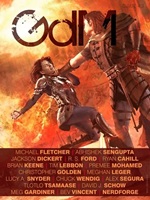“Bravery” by Michael R. Fletcher
“The Blacksmith of Lothar’s Cross” by R. S. Ford
“Death Beneath the Dread Sleeper” by Lucy A. Snyder (reprint, not reviewed)
“The Name” by Abhishek Sengupta
“We Are Vignettes” by Tlotlo Tsamaase (reprint, not reviewed)
“When the Skies Cried Crimson Rain” by Ryan Cahill
Reviewed by Victoria Silverwolf
“Bravery” by Michael R. Fletcher takes place in a fantasy world where people can inherit the skills and personality traits of dead ancestors in the form of stones. The main character inherits bravery and skill with a battle ax from his father, who was tortured and killed by enemies. During his quest for vengeance, he learns that the more abstract traits inherited by his older sister may be more important.
It is possible to interpret the supposedly magic stones as merely symbolic, with the protagonist gaining confidence through his belief in them rather than through any inherent power they possess. In any case, this familiar tale of revenge is mostly notable for the way it makes the point that bravery without wisdom is not enough.
In “The Blacksmith of Lothar’s Cross” by R. S. Ford, a man with a mysterious past arrives in a village facing hard times because of recent wars. When rogue mercenaries show up and threaten the inhabitants, he reveals his secrets.
The only fantasy element in this story is the fact that it takes place in an imaginary world. There are no supernatural occurrences. From the beginning, it is clear that the enigmatic stranger is going to go into action once the mercenaries attack. The one slightly original aspect of the story is that it is narrated by the grandmother of an orphaned boy who is the stranger’s friend.
“The Name” by Abhishek Sengupta takes place in a world where there are two rival religions. The members of one have no skins, while those belonging to the other wear multiple skins. The text alternates between the youths of two lovers, one belonging to each faith, and their relationship after the one with skins is killed (but is still around, with a new name) and her skin removed.
This unique story can not only be read as grimdark fantasy, but as body horror, surrealism, and magic realism. It can also be interpreted as an allegory for violence done in the name of religion. (The murder and skinning of the woman is explicitly called an honor killing.) Beautifully written, it creates a dreamlike mood despite its disturbing content.
In “When the Skies Cried Crimson Rain” by Ryan Cahill, werewolves are hired to escort those fleeing from their enemies. Red rain transforms those who are drenched by it into nearly unstoppable vampiric zombies.
There is more to the plot than I have indicated in this synopsis, but the story seems to exist mostly for its extremely violent scenes of battle. There is a huge body count and enormous amounts of blood and gore. Combined with the cynicism of the main characters, a fair amount of profanity, and the lack of a happy ending, this makes for an archetypical example of grimdark fantasy. Fans of this subgenre are likely to be satisfied by it, but some readers may wish for more.
Victoria Silverwolf wonders why there are two empty egg cartons at her workplace.
 Grimdark #43, July 2025
Grimdark #43, July 2025